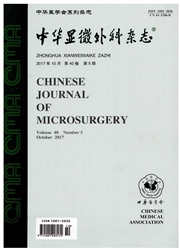

 中文摘要:
中文摘要:
目的利用小鼠角膜移植片慢性失功(CCAD)模型研究免疫和非免疫因素在CCAD发生发展过程中的作用。方法分别以C57BIM6(异系)、CB6F1(F1代)、BALB/c(同系)小鼠为供体,以BALB/c小鼠为受体进行穿透角膜移植,健康BALB/c小鼠为对照组。术后对角膜移植片进行评分;免疫组织化学法检测各组移植片CD4‘T淋巴细胞、F4/80、TGF—G、碱性成纤维细胞生长因子(bFGF)、d平滑肌肌动蛋白(d.SMA)表达;手术后1、2、3个月采用反转录PCR法检测各组小鼠角膜移植片中F4/80和TGF—B表达情况。结果异系移植组发现典型的临床免疫排斥反应并有移植片混浊,F1代和同系移植组小鼠移植片未发现临床可见的急性排斥反应而移植片透明度随时间逐渐下降,对照组角膜始终透明。异系移植组移植片基质中见大量CD4^+T淋巴细胞浸润;F1代移植组和同系移植组偶见CD4^+T淋巴细胞浸润,对照组未见CD4^+T淋巴细胞。各组角膜基质内均可见F4/80、TGF—B、bFGF阳性表达,阳性表达量随着各组免疫原性减弱而降低。术后早期各移植组F4/80表达量低,晚期表达量增高,对照组F4/80未见表达;而TGF—B各移植组早期表达量较多,晚期表达量下降,对照组各时间点均为低表达。异系移植组和F1代移植组角膜移植片发生混浊时,基质内可见d-SMA阳性表达,同系移植组呈弱阳性表达,对照组未见阳性表达。结论穿透角膜移植术后抗原依赖的免疫细胞浸润和非抗原依赖的细胞因子异常表达都参与了角膜移植片慢性失功的过程。
 英文摘要:
英文摘要:
Objective To establish a murine model of chronic corneal allograft dysfunction (CCAD) that permits molecular evaluation of alloantigen factors and non-alloantigen factors in the process of CCAD after corneal transplantation. Methods Establishment of CCAD model: C57BL/6 (allogeneic group), CB6F1 (semiallogeneic group), and BALB/c (syngeneic group) grafts were transplanted orthotopically to BALB/c recipients respectively, and BALB/c mice as a control group. Corneal opacity score was monitored. CD4^+ T lymphocytes, F4/80, TGF- β, bFGF and or- SMA were examined by imnmnohistochemistry. The expression of F4/80 and TGF- β were evaluated by reverse transcription PCR. Results Acute immune rejection episode and graft opacity were found only in allogeneneic group. The graft clearance was reduced in a time-dependant manner in semiallogeneic and syngeneic groups. Iarge amount of CD4^+ T lym- phocyte infiltration was observed in allogeneic group, few CD4^+ T lymphocytes were observed in semialloge- neic and syngeneic groups, and no CD4^+ T lymphocyte was observed in control group. The positive expressions of F4/80, TGF-β, and bFGF in the corneal stroma were observed in allogeneic, semiallogeneie and syngeneic groups. No mRNA expression of F4/80 was observed in control group. When graft opacity occuned, the positive expression of α-SMA in the corneal stroma was observed in allogeneic, semiallogeneic,and syngeneic group, but it was strongest in allogeneic group and the lowest in syngeneic group, and no expression of ot-SMA in control group. Compared with control group, the mRNA expression of TGF-β was increased in syngeneic, semiallogeneic and allogeneic groups. Conclusion AUoantigen specific and non- alloantigenspecific factors both contribute to the process of chronic allograft dysfunction after penetrating keratoplasty, and the reciprocation of the two factors may play an important role in the occurrence and devel- opment of CCAD.
 同期刊论文项目
同期刊论文项目
 同项目期刊论文
同项目期刊论文
 期刊信息
期刊信息
